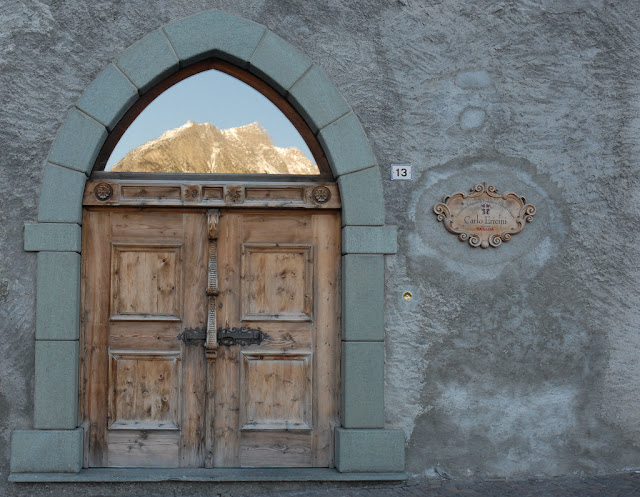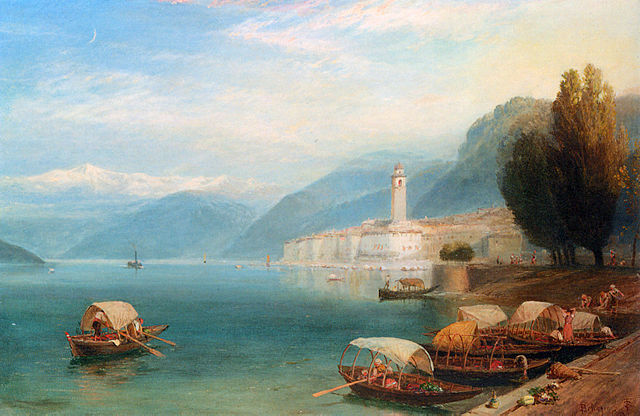Florence - Duomo Santa Maria del Fiore
Day 11, 12, 13 Touring Florence
"To see the sun sink down, drowned in pink and purple and golden floods, and overwhelm Florence with tides of color that make all the sharp lights dim and faint and turn the city into a dream, is a sight to stir the coldest nature." Mark Twain
Duomo Santa Maria del Fiore - Cathedral of St. Mary the Flower
Brunelleschi's Dome, the Nave, and Giotto's Campanile of the Cathedral
as seen from Michelangelo Hill.
In the background of the above photo is a famous clock painted by Paolo Uccello in 1443. Positioned just above the main entrance, the clock is fully functioning and one-of-a-kind. The clock face has 24 hours written in Roman numerals but in a counter-clockwise order. Unlike present-day clocks, the 24 does not mean midnight. Instead it signals sunset which was the end of the day before electric lights were invented. This is known as "Italian Time" - the way it used to be in Italy. Also, look for images of red balls which were the crest of the Midici family.
Dante Alighieri was exiled from Florence in 1302 due to his political beliefs, and he never set foot in his beloved city again. Over a century later, the city wished to commemorate their native son and pay homage to one of literature's greatest poets by commissioning this painting for the cathedral. In his legendary red hat, Dante reads his famous work, The Divine Comedy. On the left, the damned are being led to hell by demons. In the background is the mount of purgatory with Adam and Eve in the Garden of Paradise. On the right is the city of Florence.
The Dome
Enter the dome area and look up to view the fresco which depicts scenes from the Last Judgement. It was painted between 1572 and 1579 by Giorgio Vasari and Frederico Zachary. The 4,000 sq. meter dome was divided into six concentric rows placed one above the other. At the top of the lantern are 24 old men from the Apocalypse. Themes continue downward with an Angelic Chorus, Saints, Holy Ghost and Hell, Christ in Glory between Madonna and St. John above Faith, Hope and Charity, and allegorical figures of Time and the Triumphant Church. Visitors can get a much closer look by climbing a narrow passage some 400+ steps to view the frescos as well as step out on the balcony for views of Florence. (Prior reservations required.)
To get an idea of what the walk entails, watch this video.
https://youtu.be/2cPSc-tje8I
*Some literature says no bare shoulders or knees to enter.
"To see the sun sink down, drowned in pink and purple and golden floods, and overwhelm Florence with tides of color that make all the sharp lights dim and faint and turn the city into a dream, is a sight to stir the coldest nature." Mark Twain
Duomo Santa Maria del Fiore - Cathedral of St. Mary the Flower
Brunelleschi's Dome, the Nave, and Giotto's Campanile of the Cathedral
as seen from Michelangelo Hill.
Back in the 13thC, the task of building a cathedral that would rival the ones in Siena and Pisa and also reflect the importance, wealth and extraordinary power enjoyed by Florence began with Arnolfo di Cambio. Several centuries and many artisans later, the cathedral, Duomo Santa Maria del Fiore, did not disappoint. The dome, which dominates the exterior, was added in the 15thC on a design by Filippo Brunelleschi. The dome was considered one of the most significant architectural achievements of the entire Renaissance. Brunelleschi managed to create the enormous dome without supports thanks to an ingenious design as illustrated in this video.
Constructing the Dome
https://youtu.be/_IOPlGPQPuM
The Facade
The duomo is entirely covered in shades of white, green and pink marble from Tuscany, and the motif of "St. Mary the Flower" is repeated often, as is evident on the ornately decorated facade.
Below is a guide to the many features of the facade.
Constructing the Dome
https://youtu.be/_IOPlGPQPuM
The Facade
The duomo is entirely covered in shades of white, green and pink marble from Tuscany, and the motif of "St. Mary the Flower" is repeated often, as is evident on the ornately decorated facade.
Below is a guide to the many features of the facade.
Detail of the center portal with scenes of Mary's life.
Porta della Mandoria - the Almond Door
Of the 4 side doors, this one is considered a masterpiece. The gold tiled mosaic above the door depicts the angel Gabriel announcing to Mary that she would give birth to a son. Above that, the almond shaped bas-relief depicts the end of Mary's life as she ascends into Heaven.
This is the door you will enter if you choose to climb to the top of the cupola.
The Interior
While definitely subdued compared to the facade, the interior has interesting details to watch for.
The Florence Wool Guild was put in charge of overseeing all
the work done on the cathedral by the various guilds. The operation was called "Opera del Duomo" or OPA. Their symbol, a lion holding a cross, can be seen in and around the church.
OPA also means "Pray for Souls".
Porta della Mandoria - the Almond Door
Of the 4 side doors, this one is considered a masterpiece. The gold tiled mosaic above the door depicts the angel Gabriel announcing to Mary that she would give birth to a son. Above that, the almond shaped bas-relief depicts the end of Mary's life as she ascends into Heaven.
This is the door you will enter if you choose to climb to the top of the cupola.
The Interior
The Florence Wool Guild was put in charge of overseeing all
the work done on the cathedral by the various guilds. The operation was called "Opera del Duomo" or OPA. Their symbol, a lion holding a cross, can be seen in and around the church.
OPA also means "Pray for Souls".
Interesting floor mosaics.
Dante Alighieri was exiled from Florence in 1302 due to his political beliefs, and he never set foot in his beloved city again. Over a century later, the city wished to commemorate their native son and pay homage to one of literature's greatest poets by commissioning this painting for the cathedral. In his legendary red hat, Dante reads his famous work, The Divine Comedy. On the left, the damned are being led to hell by demons. In the background is the mount of purgatory with Adam and Eve in the Garden of Paradise. On the right is the city of Florence.
The Dome
Enter the dome area and look up to view the fresco which depicts scenes from the Last Judgement. It was painted between 1572 and 1579 by Giorgio Vasari and Frederico Zachary. The 4,000 sq. meter dome was divided into six concentric rows placed one above the other. At the top of the lantern are 24 old men from the Apocalypse. Themes continue downward with an Angelic Chorus, Saints, Holy Ghost and Hell, Christ in Glory between Madonna and St. John above Faith, Hope and Charity, and allegorical figures of Time and the Triumphant Church. Visitors can get a much closer look by climbing a narrow passage some 400+ steps to view the frescos as well as step out on the balcony for views of Florence. (Prior reservations required.)
To get an idea of what the walk entails, watch this video.
https://youtu.be/2cPSc-tje8I
*Some literature says no bare shoulders or knees to enter.
Photo credits in order:
4. labels added by blogger
6. https://flic.kr/p/ay7Ypy
7. https://it.wikipedia.org/wiki/Porta_della_Mandorla#/media/File:Porta_della_mandorla_02.JPG
7. https://it.wikipedia.org/wiki/Porta_della_Mandorla#/media/File:Porta_della_mandorla_02.JPG
8. https://en.wikipedia.org/wiki/Florence_Cathedral#/media/File:Duomo_Firenze_Apr_2008.jpg
9. https://en.wikipedia.org/wiki/Guilds_of_Florence#/media/File:Arte_Lana_Della_Robbia_OPA_Florence.jpg
10. https://flic.kr/p/j1Y8hy
11. https://flic.kr/p/vMSPab
12. https://en.wikipedia.org/wiki/Florence_Cathedral#/media/File:Dante_Domenico_di_Michelino_Duomo_Florence.jpg
13. https://pixabay.com/images/id-3605022/
9. https://en.wikipedia.org/wiki/Guilds_of_Florence#/media/File:Arte_Lana_Della_Robbia_OPA_Florence.jpg
10. https://flic.kr/p/j1Y8hy
11. https://flic.kr/p/vMSPab
12. https://en.wikipedia.org/wiki/Florence_Cathedral#/media/File:Dante_Domenico_di_Michelino_Duomo_Florence.jpg
13. https://pixabay.com/images/id-3605022/
Photo credits in order:
1.















Comments
Post a Comment